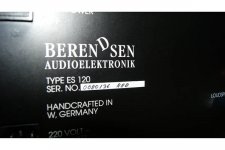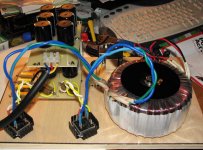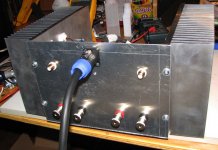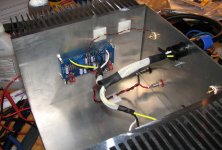What have people found to be the level of capacitance in the power supply where you hit diminishing returns. I am sure Mr. Pass would say that anything more then stock would be this point but I am curious to see what some of you have found from building your own amps.
Concerning capacitance, does the F5 being class-A have any more or less requirement for supply capacitance than, say, a class-AB amp?
> FQA36P15/FQA28N15 in TO3P package and with gms of 19.5/20S, power 294/227W
Those gm values are at 18A. I guess you are not going to bias at 18A.
So at around 2A, gm would still be like 3S or so.
Patrick
.
No, I would not plan to bias them at 18A obviously, however the gm does
matter at high current with regard to the drive requirements at peak output
current.
I imagine the capacitance would be roughly proportional to the
transconductance.
😎
Strange, the N part has less than the IRFP240 whereas the P part has significantly more.
Strange, the N part has less than the IRFP240 whereas the P part has significantly more.
In that case the transconductance of N and P is about the same.
N and P fets are technically different animals with the P having only half the charge carrier mobility of the Ns. So either the N and P have the same capacitance but the P has only half the Ns transconductance (popular IRFPs come to mind) or the N and Ps have the same transconductance but the P have twice the capacitance of the Ns (popular Toshibas come to mind) as the Ps die size is twice as large.
Hannes
F5 being class-A have any more or less requirement for supply capacitance than a class-AB amp?
1 Think ripple, S/N of an amp is governed by noise supression by the circuit plus the ripple voltage part.
2 Caps are charged at 1/120th second intervals (in the US). Inbetween diode conduction, the PS capacitors of a Classy A are drained faster due to the higher quiescent current. Sorta of like half of the caps are there for the bias current, other half for the music signal.

(average figure for commercial manufacture Class A power amps is 1000uF per Watt output power in 8 ohm, per channel. Statistics junkie is me)
... the level of capacitance in the power supply where you hit diminishing returns
As Jacco indicated, about 20,000uF per rail/channel for diy version of this amp (about double the commercial 'rule of thumb') - very dependent on cap quality, naturally - ie 10,000uF of Nichicon Gold Tone will give better results than 20,000uF Panasonic TSHU for example, in a typical C-R-C supply - big difference in cost, mind you, if you use the 4 caps / channel!
Quite a few vendors on this site for good caps to suit.
commercial 'rule of thumb'
Thing to keep in mind is that lots of commercial Class A power amps are biased to a level that equals the continuous power figure, not peak power.
Commercial manufacture, remember.
Means bias is ~30% lower, saves on : heatsinks, output devices, transformer size, and PS caps.
Real Class A push-pull is biased to half the peak output current in an 8 Ohm load.
Real-Real Class A is biased to half the peak output current in a 4 Ohm load, but you're not likely to bump into one of those.
CRC, despite the additional ripple damping trick, actually needs more capacitance.
PS cap size depends on what one intends to do with the amp, applies to both Class A and AB.
Example : Berendsen audio
Berendsen Audio - Produkte - Spezifikationen Endstufe
Berendsen offers that option for the last 20 years or so, early products were ES60 and ES120 Class AB amps, standard or Red edition (bigger powersupply)
Attachments
My F5
Here are some pictures of my F5. This is my first ever amp build. It is still not 100% complete, but it is making beautiful music! I wanted to keep the chassis small so the power supply is separate from the amp. Also I will be able to use the power supply for other F amps if I choose to experiment. Thank you to Nelson for providing such nice design. Thank you to all those who have built and posted before me, your pics and experiences have been helpful and inspirational.
Jim
Here are some pictures of my F5. This is my first ever amp build. It is still not 100% complete, but it is making beautiful music! I wanted to keep the chassis small so the power supply is separate from the amp. Also I will be able to use the power supply for other F amps if I choose to experiment. Thank you to Nelson for providing such nice design. Thank you to all those who have built and posted before me, your pics and experiences have been helpful and inspirational.
Jim
Attachments
the power supply is separate from the amp.
Very good idea! 😎
Keeps the humm out of the amp 😉 Even more so if you would like to go with a small chassis!
Just use sufficiently thick cabling and some onboard decoupling caps.
Hannes
Hi, can the first watt F5 drive very low impedance speaker? For example, the apogee scintilla, where the impedance drops to 0.5 ohms?
I know a Dr.H who's all into crown amps, wierd😀Hi, can the first watt F5 drive very low impedance speaker? For example, the apogee scintilla, where the impedance drops to 0.5 ohms?
I never thought of that, but how much would it help? I'm getting ready to build my first 6v6 from boozhound labs and I want to make it the best I can.Very good idea! 😎
Keeps the humm out of the amp 😉 Even more so if you would like to go with a small chassis!
Just use sufficiently thick cabling and some onboard decoupling caps.
Hannes
two leds parallel
Hi friends,
I'm building an F5 and I'm using parts methacrylate. I'm using the plates cviller 1.1. The PCB has holes to solder LEDs with cable or mounted on the plate.
I can use this pair of holes to mount two LEDs in parallel with its corresponding resistance? Will it affect the sound charge led PSU with a more?.
The LEDs are blue.
Thanks for your reply. Excuse my English.
Hi friends,
I'm building an F5 and I'm using parts methacrylate. I'm using the plates cviller 1.1. The PCB has holes to solder LEDs with cable or mounted on the plate.
I can use this pair of holes to mount two LEDs in parallel with its corresponding resistance? Will it affect the sound charge led PSU with a more?.
The LEDs are blue.
Thanks for your reply. Excuse my English.
Hi, can the first watt F5 drive very low impedance speaker? For example, the apogee scintilla, where the impedance drops to 0.5 ohms?
I believe I've answered this privately, but for the public record:
Not really.
😎
Just use sufficiently thick cabling and some onboard decoupling caps.
Hannes
I think the cable is good. 12 gauge by four conductors. As I said I am new here and this is my first amp build. What is the reason for decoupling caps with a remote power supply?
Thank you,
Jim
- Home
- Amplifiers
- Pass Labs
- F5 power amplifier





